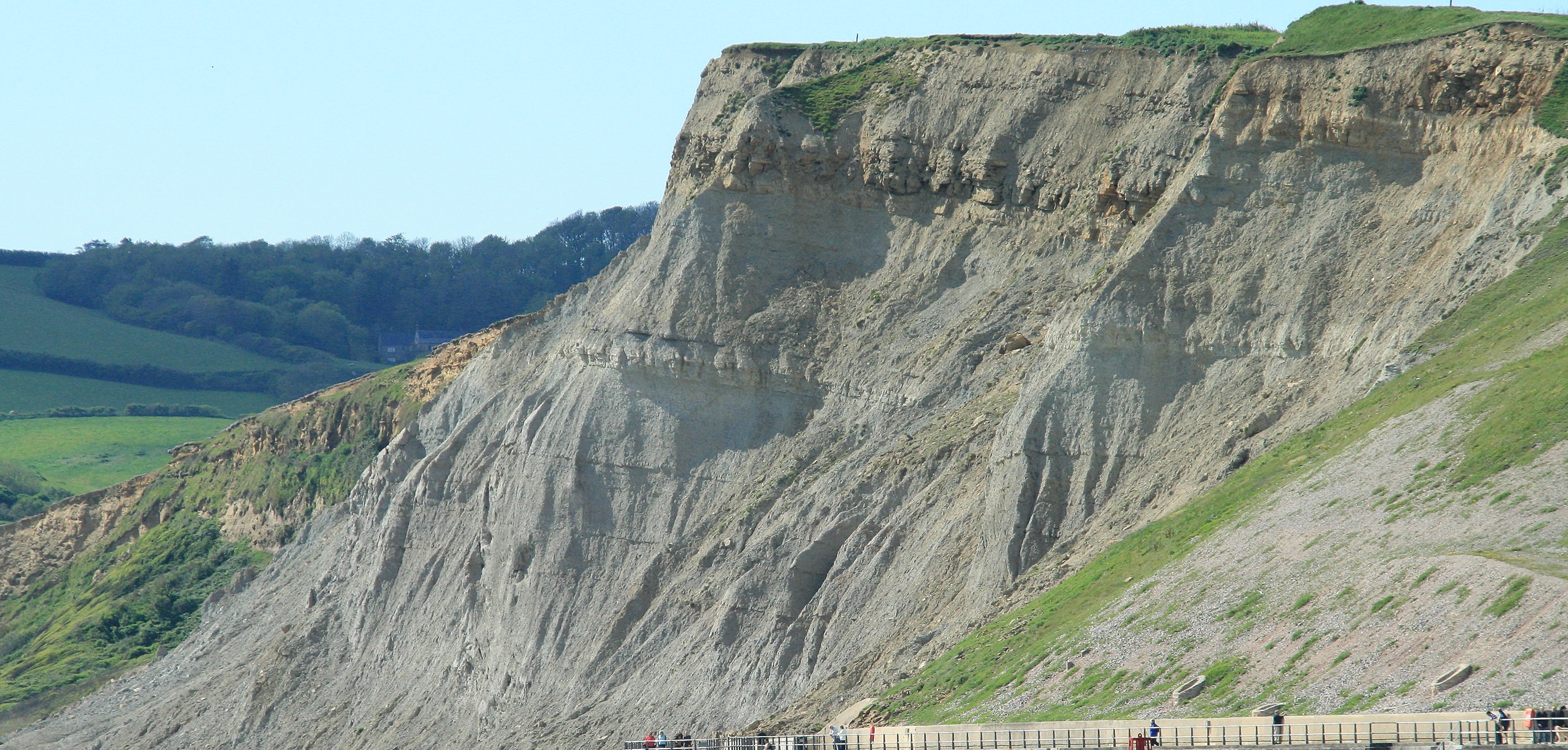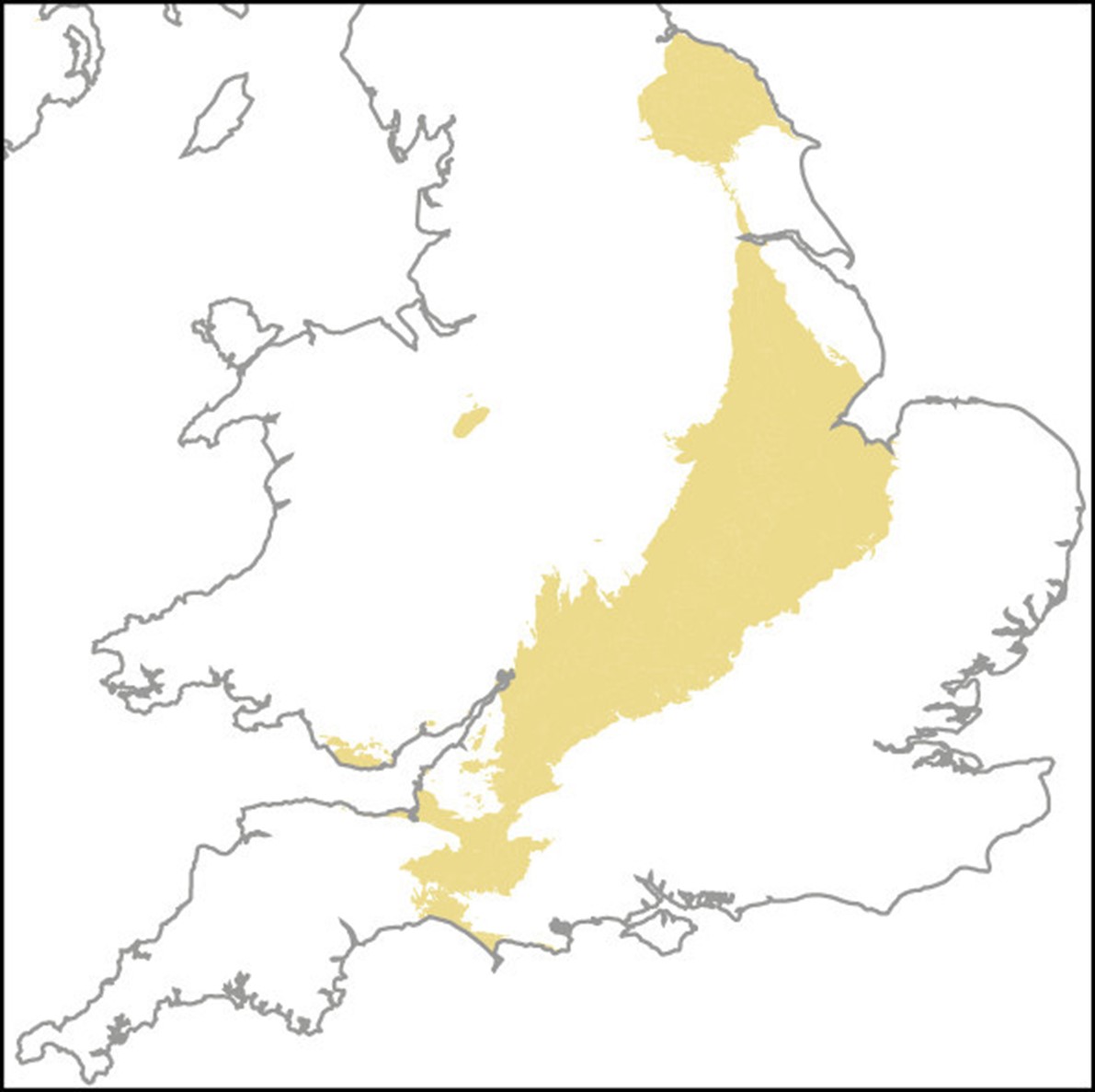
Geological Names

 |
West Bay Geology
Geological Names |
 |
Rocks are named according to the time when they were formed, or perhaps more precisely when they were "deposited", as most rocks that we see are just the worn-down remnants of previous rocks, which in turn were probably formed from other older rocks, and so on! So, by convention, the age of a rock is taken as the time when it was "last" deposited and then consolidated from sediment into a hard and compact rock.
The oldest rocks in this country are found in the northwest of Scotland. They are around 1,800 million years old and are part of what is called the Pre-Cambrian age, a term that encompasses all rocks that are older than 540 million years old. As a sidenote this definition is not arbitrary but reflects the fact that significant and abundant fossils "suddenly" appear 540 million years ago, as evolution had found a way for organisms to start to build limestone shells which then can be seen as fossils. The youngest true rocks, as opposed to unconsolidated surface deposits left by the recent ice age, are found in the southeast of the country and are just a few million years old and are given the name Pliocene. This pattern of older rocks in the NW and younger in the SE is a key feature of the geology of the British Isles and this trend is closely connected with the long-term history of the part of the Earth's crust that we now call home, (more on this later).
The table below shows all of the main named geological periods.
 Note that in order to make the text the same size that the vertical "scale" is not linear, and this makes the more recent periods appear relatively longer than they actually are
Note that in order to make the text the same size that the vertical "scale" is not linear, and this makes the more recent periods appear relatively longer than they actually are
The rocks in our area are of the Jurassic and Cretaceous periods, and are between 200 million and 125 million years old. So, despite this seeming an impossibly long time ago, the rocks we see along outs stretch of coast are in world terms really quite young, perhaps something like "teenagers" in geological terms. Jurassic rocks are found at the surface everywhere along a broad band heading across the country from cliffs in Dorset through the Midlands, Nottinghamshire and on into Yorkshire. In geological terms (and probably not much else!) the Dorset coast is very strongly twinned with the Yorkshire coast.
The map below shows the part of the country that have Jurassic rocks at the surface. We (along with Yorkshire) might have the Jurassic coast but inland there are lots of areas sporting Jurassic hills and valleys.

This just shows the outcrop at the surface of Jurassic rocks. They can also be found underground, i.e. buried beneath younger rocks which are exposed at the surface, over a much wider area that stretches East to London and beyond to the East coast and Westward into Devon.
Anyway, on to the strange names! Geological periods are named after either localities which show these rocks well, or occasionally after aspects of the rocks themselves. Jurassic is named after the Jura mountains found between France and Switzerland. The French geologists stole a march on the British ones in naming rocks of this age. The early British geologists were very practical sorts, (quite different from the fun loving French), and much more interested in describing the older coal bearing rocks than in "wasting time" on what they considered as the "non-productive" Jurassic rocks. Cretaceous is named after the Latin word for Chalk, as this is the key rock type found, and also one that is found over a wide geographical area. Each Geological period is then split up into further sub-divisions, and in fact many of these get further divided into sub sub divisions, (and indeed often sub-sub-sub divisions!). The rocks that we see in the Cliffs are some of the earlier rocks within the Jurassic, or to use the correct geological term "Lower Down" within the Jurassic. These early Jurassic divisions are listed below, youngest at the top and oldest at the bottom.
| Name | Age Million Years |
Named After | Rock Name in Dorset |
| Oxfordian | 160 |
Named after Oxford | Oxford Clay |
| Callovian | 162 |
Named after the Latin version of Kellaways near Chippenham | Cornbrash Forest Marble |
| Bathonian | 165 |
Named after Bath | Frome Clay Inferior Oolite |
| Bajocian | 170 |
After French town of Bayeux (yes the one with the tapestry) | Bridport Sands (could easily be called Bayeux Sands!) |
| Toarcian | 175 |
After French town of Thouars | Down Cliff Clay Junction Bed |
| Pliensbachian | 185 |
After German town called Pliensbach | Thorncombe Sands Down Cliff Sands Eype Clay |
| Sinemurian | 195 |
After Semur in France | Green Ammonite Beds Belemnite Marls Black Venn Marls |
| Hettangian | 200 |
After Hetange in France | Blue Lias |
Luckily for anyone not studying Geology none of these strange names matters that much as we can (and probably should) talk about the individual rocks using their locally recognised names, for example Bridport Sands (which happen to be Bajocian), or Eype Clay (which happens to be Pliensbachian). Much easier to remember, though of course if you really want to impress any house guests you have staying then I can fully recommend trying out the formal sub-period names on them.
I find that something like "We had a lovely row under the Pleinsbachian cliffs today" always gets peoples' interest, (even if it is just to give me a strange look). Much more so than saying we "had a lovely row down to Eype".
Of course for those studying Geology these names are a bit of a rite of passage. I remember very well having to learn all of the sub division names for the geological periods, and can still remember the mnemonics that I used to help me. HSPTBBCOK is the rather strange one that I used covering the lower and middle Jurassic rocks, which I rememberd then (and still do today) for some strange reason as "Hotspot, BBC, OK". As a side-note I started drinking Gin when studying Geology. It is perfectly possibly that Gin is a pre-requisite to really get to grips with all of this, though I guess someone needs to do some detailed (practically based) experiments to prove this. If anyone is interested in undertaking such research then I can provide the Gin
It is also very important to understand just how long a period of time we are talking about here. The Bridport Sands (East Cliff) formed over a period of around 5 million years. This is just 0.2% of the age range of British rocks but it is also 50 times longer than there have been modern humans on the planet. This is also a fantastically slow rate of deposition averaging out to just one millimetre every hundred years. The current cliffs are wearing down at the rate of metres every few years. What we see today as solid cliffs are just a very transient feature in a long term picture, a bit like a single frozen frame in a film. When we see rocks in the cliff these are not just the solidified remains of sand on a beach or the mud in a lagoon, but they are the result of the wearing down of whole mountain ranges, the drifting of continents, or the long-term change in sea levels of hundreds of metres, not the centimetres that we are experiencing now.
The coastal erosion that we see happen now is just a tiny (though not completely insignificant part), of the wider picture of geological processes that amongst other things leads to rocks being formed.
In some places single moments in time are captured, the best example in our area might be the wave formed ripples captured on the bedding planes of some of the rocks, and which can be seen on some of the slabs as they erode on the beach. However, these are not common and also often difficult to completely interpret in terms of specific single events. Even if such ripples do repreent a single beach between tides, this is perhaps just like finding a small celluloid cutting from a film, without any of the context that woyuld allow us to work out what type of film it was actualy from.